A System Analysis on Steppe Sustainability and Its Driving Forces—A Case Study in China
Abstract
:1. Introduction
2. Materials and Methods
2.1. Study Area
2.2. Data Source and Processing
2.3. Assessing Methods on Dynamics of Steppe Sustainability
2.3.1. Monitoring Method on Steppe Sustainability Dynamics
2.3.2. Effect on Steppe Sustainability Analysis Base on Effect Matrix
2.4. Analysis Methods on Driving Forces of Steppe Sustainability Dynamics
2.4.1. Natural Driving Forces Analysis with Copula Model
2.4.2. Anthropogenic Driving Forces Analysis Based on Land-Cover Class Conversions
3. Results
3.1. Dynamics of Steppe Sustainablitly in CHINA
3.2. The Effect of Steppe Dynamics on Steppe Sustainability in China
3.3. Natural Driving Forces of Steppe Sustainablitly in China
3.4. Anthropogenic Driving Forces of Steppe Sustainablitly in China
4. Discussion
4.1. Methodology
4.2. Dynamics of Steppe Sustainability
4.3. Driving Forces of Dynamics of Steppe Sustainability
5. Conclusions
Acknowledgments
Author Contributions
Conflicts of Interest
References
- Sims, P.; Risser, P. Grasslands. In North American Terrestrial Vegetation; Barbour, M., Billings, W., Eds.; Cambridge University Press: New York, NY, USA, 2000; pp. 323–356. [Google Scholar]
- Suttie, J.M.; Reynolds, S.G.; Batello, C. Grasslands of the World; Food & Agriculture Organization: Rome, Italy, 2005; Volume 34, pp. 1–356. [Google Scholar]
- Xu, D.D.; Guo, X.L. Evaluating the impacts of nearly 30 years of conservation on grassland ecosystem using Landsat TM images. Grassl. Sci. 2015, 61, 227–242. [Google Scholar] [CrossRef]
- Han, Y.; Gao, X.; Gao, J.; Xu, Y.M.; Liu, C. Typical ecosystem services and evaluation indicator system of significant eco-function areas. Ecol. Environ. Sci. 2010, 19, 2986–2992. [Google Scholar]
- Scurlock, J.M.O.; Johnson, K.; Olson, R.J. Estimating net primary productivity from grassland biomass dynamics measurements. Glob. Chang. Biol. 2002, 8, 736–753. [Google Scholar] [CrossRef]
- Nan, Z.B. The grassland farming system and sustainable agricultural development in China. Grassl. Sci. 2005, 51, 15–19. [Google Scholar] [CrossRef]
- Akiyama, T.; Kawamura, K. Grassland degradation in China: Methods of monitoring, management and restoration. Grassl. Sci. 2007, 53, 1–17. [Google Scholar] [CrossRef]
- Zhang, Z.M.; Yan, J.P.; Zhang, X.M. The theory basis, the principle and the corresponding policy suggestion to the mechanism of reparation for rangeland ecology balance in China. J. Arid Land Resour. Environ. 2007, 21, 142–146. (In Chinese) [Google Scholar]
- Kawada, K.; Wu, Y.; Nakamura, T. Land degradation of abandoned croplands in the Xilingol steppe region, Inner Mongolia, China. Grassl. Sci. 2011, 57, 58–64. [Google Scholar] [CrossRef]
- Wu, K.; Ye, X.; Qi, Z.; Zhang, H. Impacts of land use/land cover change and socioeconomic development on regional ecosystem services: The case of fast-growing Hangzhou metropolitan area, China. Cities 2013, 31, 276–284. [Google Scholar] [CrossRef]
- Wan, L.; Ye, X.; Lee, J.; Lu, X.; Zheng, L.; Wu, K. Effects of urbanization on ecosystem service values in a mineral resource-based city. Habitat Int. 2015, 46, 54–63. [Google Scholar] [CrossRef]
- Braimoh, A.K.; Onishi, T. Spatial determinants of urban land use change in Lagos, Nigeria. Land Use Policy 2007, 24, 502–515. [Google Scholar] [CrossRef]
- Dewan, A.M.; Yamaguchi, Y.; Ziaur, M. Dynamics of land use/cover changes and the analysis of landscape fragmentation in Dhaka Metropolitan, Banglade. GeoJournal 2012, 77, 315–330. [Google Scholar] [CrossRef]
- Li, X.M.; Zhou, W.Q.; Ouyang, Z.Y. Forty years of urban expansion in Beijing: What is the relative importance of physical, socioeconomic, and neighborhood factors? Appl. Geogr. 2013, 38, 1–10. [Google Scholar] [CrossRef]
- Dewan, A.M.; Yamaguchi, Y. Land use and land cover change in Greater Dhaka, Bangladesh: Using remote sensing to promote sustainable urbanization. Appl. Geogr. 2009, 29, 390–401. [Google Scholar] [CrossRef]
- Clement, F.; Amezaga, J.M. Linking reforestation policies with land use change in northern Vietnam: Why local factors matter. Geoforum 2008, 39, 265–277. [Google Scholar] [CrossRef]
- Ahl, D.E.; Gower, S.T.; Burrows, S.N.; Shabanov, N.V.; Ranga, B.; Knyazikhin, Y. Monitoring spring canopy phenology of a deciduous broadleaf forest using MODIS. Remote Sens. Environ. 2006, 104, 88–95. [Google Scholar] [CrossRef]
- Gang, C.C.; Zhou, W.; Chen, Y.Z.; Wang, Z.Q.; Sun, Z.G.; Li, J.L.; Qi, J.G.; Inakwu, O. Quantitative assessment of the contributions of climate change and human activities on global grassland degradation. Environ. Earth Sci. 2014, 72, 4273–4282. [Google Scholar] [CrossRef]
- Archibald, O.W. Ecology of World Vegetation; Springer Science & Business Media: Berlin, Germany, 2012. [Google Scholar]
- Jin, J.; Wang, Q. Assessing ecological vulnerability in western China based on Time–Integrated NDVI data. J. Arid Land. 2016, 8, 533–545. [Google Scholar] [CrossRef]
- Chun, M. Analysis of Ecological Vulnerability of Grassland in Yushu of China Based on Landscape Pattern. J. Landsc. Res. 2012, 2012, 53–54. [Google Scholar]
- Zhang, J.T.; Zhang, G.L. Ecological situation and management of Bothriochloa ischaemum grasslands in China. Grassl. Sci. 2006, 52, 85–93. [Google Scholar] [CrossRef]
- Zhou, H.K.; Zhao, X.Q.; Tang, Y.H.; Gu, S.; Zhou, L. Alpine grassland degradation and its control in the source region of the Yangtze and Yellow Rivers. China Grassl. Sci. 2005, 51, 191–203. [Google Scholar] [CrossRef]
- Qian, S.; Wu, M.X.; Cheng, L.; Cao, Y. Study on Assessment of Ecological Environment Quality of Main Grassland in China since 2001. Chin. Agric. Bull. Suppl. 2014, 30, 81–86. [Google Scholar]
- Brieckle, S.W. Walter’s Vegetation of the Earth, 4th ed.; Springer: Berlin, Germany, 2000; pp. 1–10. [Google Scholar]
- Liu, X.Y.; Long, R.J.; Shang, Z.H. Evaluation method of ecological services function and their value for grassland ecosystems. Acta Pratacult. Sin. 2011, 1, 167–174. [Google Scholar]
- Dulamsuren, C.; Hauck, M.; Muhlenberg, M. Ground vegetation in the Mongolian taiga forest–steppe ecotone does not offer evidence for the human origin of grasslands. Appl. Veg. Sci. 2005, 8, 149–154. [Google Scholar] [CrossRef]
- Yang, B.J.; Ma, Y.X.; Li, B. Protection and Construction of Grassland in China: Investigation in the Inner Mongolia. China Dev. 2010, 10, 1–5. (In Chinese) [Google Scholar]
- Bujak, A.; Sliwa, Z. Global aspects of security environment–the “One Belt, One Road” project. Econ. Prawo 2016, 15, 439–454. [Google Scholar] [CrossRef]
- Xiao, T.; Wang, J.; Chen, Z. Vulnerability of Grassland Ecosystems in the Sanjiangyuan Region Based on NPP. Resour. Sci. 2010, 32, 323–330. (In Chinese) [Google Scholar]
- Wessels, K.J.; Prince, S.D.; Reshef, I. Mapping land degradation by comparison of vegetation production to spatially derived estimates of potential production. J. Arid Environ. 2008, 72, 1940–1949. [Google Scholar] [CrossRef]
- Jacquin, A.; Sheeren, D.; Lacombe, J.P. Vegetation cover degradation assessment in Madagascar savanna based on trend analysis of MODIS NDVI time series. Int. J. Appl. Earth Obs. 2010, 12, S3–S10. [Google Scholar] [CrossRef]
- Potter, C.; Klooster, S.; Genovese, V. Net primary production of terrestrial ecosystems from 2000 to 2009. Clim. Chang. 2012, 115, 365–378. [Google Scholar] [CrossRef]
- Eckert, S.; Husler, F.; Liniger, H.; Hodel, E. Trend analysis of MODIS NDVI time series for detecting land degradation and regeneration in Mongolia. J. Arid Environ. 2015, 113, 16–28. [Google Scholar] [CrossRef]
- Khalid, M.; Onisimo, M.; Elhadi, A.; Elfatih, A.R.M. Multispectral remote sensing for mapping grassland degradation using the key indicators of grass species and edaphic factors. Geocarto Int. 2015, 31, 477–491. [Google Scholar]
- Liu, J.; Yang, X.; Liu, H.L.; Qiao, Z. Algorithms and Applications in Grass Growth Monitoring. Abstr. App. Anal. 2013, 2013, 900–914. [Google Scholar] [CrossRef]
- Hunt, J.; Raymond, E.; Everitt, J.H.; Ritchie, J.C.; Moran, M.S.; Booth, D.T. Applications and research using remote sensing for rangeland management. Photogramm. Eng. Remote Sens. 2003, 69, 675–693. [Google Scholar] [CrossRef]
- Kawamura, K.; Akiyama, T.; Yokota, H.; Tsutsumi, M.; Yasuda, T.; Watanabe, O.; Wang, S.P. Comparing MODIS vegetation indices with AVHRR NDVI for monitoring the forage quantity and quality in Inner Mongolia grassland, China. Grassl. Sci. 2005, 51, 33–40. [Google Scholar] [CrossRef]
- Wei, O.Y.; Hao, F.H.; Skidmore, A.K.; Groen, T.A.; Toxopeus, A.G.; Wang, T.J. Integration of multi–sensor data to assess grassland dynamics in a Yellow River sub–watershed. Ecol. Indic. 2012, 18, 163–170. [Google Scholar]
- Wang, B.Y.; Han, T.H.; Sun, B. Temporal and spatial dynamic of grassland based on MODIS NDVI during 2001–2015 in Gansu Province. China Herbiv. Sci. 2016, 36, 39–41. (In Chinese) [Google Scholar]
- Asrar, G.; Myneni, R.B.; Li, Y.; Kanemasu, E.T. Measuring and modeling spectral characteristics of a tallgrass prairie. Remote Sens. Environ. 1989, 27, 143–155. [Google Scholar] [CrossRef]
- Baret, F. Potentials and limits of vegetation indices for LAI and APAR assessment. Remote Sens. Environ. 1991, 35, 161–173. [Google Scholar] [CrossRef]
- Ikeda, H.; Fukuhara, M.; Okamoto, K. Estimation of aboveground grassland phytomass with a growth model using Landsat TM and climate data. Int. J. Remote Sens. 1999, 11, 2283–2294. [Google Scholar] [CrossRef]
- Zhang, X.Y.; Friedl, M.A.; Schaaf, C.B.; Strahler, A.H.; Hodges, J.C.F.; Gao, F.; Reed, B.C.; Huete, F. Monitoring vegetation phenology using MODIS. Remote Sens. Environ. 2003, 84, 471–475. [Google Scholar] [CrossRef]
- Eastman, J.R.; Sangermano, F.; Ghimire, B.; Zhu, H.L.; Chen, H.; Neeti, N.; Cai, Y.M.; Machado, E.A.; Crema, S.C. Seasonal trend analysis of image time series. Int. J. Remote Sens. 2009, 30, 2721–2726. [Google Scholar] [CrossRef]
- Verbesselt, J.; Hyndmanb, R.; Newnhama, G.; Gulvenor, D. Detecting trend and seasonal changes in satellite image time series. Remote Sens. Environ. 2010, 114, 106–115. [Google Scholar] [CrossRef]
- Li, Z.; Huffman, T.; Mcconkey, B.; Lawrence, T.S. Monitoring and modeling spatial and temporal patterns of grassland dynamics using time–series MODIS NDVI with climate and stocking data. Remote Sens. Environ. 2013, 138, 232–244. [Google Scholar] [CrossRef]
- Jin, Y.X.; Xu, B.; Yang, X.C.; Qin, Z.H.; Wu, Q.; Zhao, F.; Chen, S.; Li, J.Y.; Ma, H.L. MODIS–based vegetation growth of temperate grassland and its correlation with meteorological factors in northern China. Int. J. Remote Sens. 2015, 36, 5123–5136. [Google Scholar] [CrossRef]
- Li, S.S.; Yang, S.N.; Liu, X.F.; Liu, Y.X.; Shi, M.M. NDVI–Based Analysis on the Influence of Climate Change and Human Activities on Vegetation Restoration in the Shaanxi–Gansu–Ningxia Region. Cent. China Remote Sens. 2015, 7, 11163–11182. [Google Scholar] [CrossRef]
- Nemani, R.R.; Keeling, C.D.; Hashimoto, H.; Jolly, W.M.; Piper, S.C. Climate–driven increases in global terrestrial net primary production from 1982 to 1999. Science 2003, 300, 1560–1563. [Google Scholar] [CrossRef] [PubMed]
- Gao, Y.Z.; Chen, Q.; Lin, S.; Marcus, G.; Holger, B. Resource manipulation effects on net primary production, biomass allocation and rain–use efficiency of two semiarid grassland sites in Inner Mongolia, China. Oecologia 2011, 165, 855–864. [Google Scholar] [CrossRef] [PubMed]
- Wang, X.X.; Li, F.L.; Gao, R.Z.; Luo, Y.Y.; Liu, T.X. Predicted NPP spatiotemporal variations in a semiarid steppe watershed for historical and trending climates. J. Arid. Environ. 2014, 104, 67–79. [Google Scholar] [CrossRef]
- Reeves, M.C.; Moreno, A.L.; Bagne, K.E. Estimating climate change effects on net primary production of rangelands in the United States. Clim. Chang. 2014, 126, 429–442. [Google Scholar] [CrossRef]
- Whitney, M.; Dana, B.; Karie, C.; Anine, S.; Amy, S.; Lance, V.; Scott, C.; Melinda, S.; Alan, K. Climatic controls of aboveground net primary production in semi–arid grasslands along a latitudinal gradient portend low sensitivity to warming. Oecologia 2015, 177, 959–969. [Google Scholar]
- Zhou, W.; Gang, C.C.; Zhou, F.C.; Li, J.L.; Dong, X.G.; Zhao, C.Z. Quantitative assessment of the individual contribution of climate and human factors to desertification in northwest China using net primary productivity as an indicator. Ecol. Indic. 2015, 48, 560–569. [Google Scholar] [CrossRef]
- Liu, B.; You, G.Y.; Li, R.; Shen, W.S.; Yue, Y.M.; Lin, N.F. Spectral characteristics of alpine grassland and their changes responding to grassland degradation on the Tibetan Plateau. Environ. Earth Sci. 2015, 74, 2115–2123. [Google Scholar] [CrossRef]
- Xu, B.; Tao, W.G.; Yang, X.C.; Qin, Z.H.; Liu, H.Q.; Miao, J.M. MODIS–Based Remote Sensing Monitoring upon the Vegetation Growth of China’s Grassland. Acta Agrestia Sin. 2006, 14, 242–247. (In Chinese) [Google Scholar]
- Chen, J.; Masae, S.; Wu, Y.N.; Yoshimichi, H.; Yasuo, Y. Vegetation and its spatial pattern analysis on salinized grasslands in the semiarid Inner Mongolia steppe. Grassl. Sci. 2015, 61, 121–130. [Google Scholar] [CrossRef]
- Li, A.; Wu, J.; Huang, J. Distinguishing between human-induced and climate-driven vegetation changes: A critical application of RESTREND in inner Mongolia. Landsc. Ecol. 2012, 27, 969–982. [Google Scholar] [CrossRef]
- Xu, D.Y.; Kang, X.W.; Zhuang, D.F.; Pan, J.J. Multi–scale quantitative assessment of the relative roles of climate change and human activities in desertification: A case study of the Ordos Plateau, China. J. Arid. Environ. 2010, 74, 498–507. [Google Scholar] [CrossRef]
- Zhang, C.X.; Wang, X.M.; Li, J.C.; Hua, T. Roles of climate changes and human interventions in land degradation: A case study by net primary productivity analysis in China’s Shiyanghe Basin. Environ. Earth Sci. 2011, 64, 2183–2193. [Google Scholar] [CrossRef]
- Mao, D.H.; Wang, Z.M.; Han, J.X.; Ren, C.Y. Spatio–temporal pattern of net primary productivity and its driven factors in northeast China in 1982–2010. Sci. Geogr. Sin. 2012, 32, 1106–1111. (In Chinese) [Google Scholar]
- He, C.Y.; Tian, J.; Gao, B.; Zhao, Y.Y. Differentiating climate– and human–induced drivers of grassland degradation in the Liao River Basin, China. Environ. Monit. Assess. 2015, 187, 1–14. [Google Scholar] [CrossRef] [PubMed]
- Xu, H.J.; Wang, X.P.; Zhang, X.X. Alpine grasslands response to climatic factors and anthropogenic activities on the Tibetan Plateau from 2000 to 2012. Ecol. Eng. 2016, 92, 251–259. [Google Scholar] [CrossRef]
- Herrmann, S.M.; Anyamba, A.; Tucker, C.J. Recent trends in vegetation dynamics in the African Sahel and their relationship to climate. Glob. Environ. Chang. 2005, 15, 394–404. [Google Scholar] [CrossRef]
- Mu, S.J.; Yang, H.F.; Li, J.L.; Chen, Y.Z.; Gang, C.C.; Zhou, W.; Ju, W.M. Spatio–temporal dynamics of vegetation coverage and its relationship with climate factors in Inner Mongolia, China. J. Geogr. Sci. 2013, 23, 231–246. [Google Scholar] [CrossRef]
- Ge, Q.S.; Fang, X.Q.; Zhang, X.Q.; Wu, S.H. Remarkable environmental changes in China during the past 50 years: A case study on regional research of global environmental change. J. Geogr. Res. 2005, 3, 345–358. [Google Scholar]
- Wang, X.G.; Luo, J.Q. “Combination of heavy” attack to curb grassland degradation. Proc. China Grassl. Dev. Forum. 2006, 1, 328–330. [Google Scholar]
- Zhou, W.; Gang, C.C.; Zhou, L.; Chen, Y.Z.; Li, J.L.; Ju, W.M.; Inakwu, O. Dynamic of grassland vegetation degradation and its quantitative assessment in the northwest China. Acta Oecol. 2014, 55, 86–96. [Google Scholar] [CrossRef]
- Tukey, J.W. Exploratory Data Analysis; Reading Mass; Addison-Wesley: Boston, MA, USA, 1977. [Google Scholar]
- Holttinen, H.; Milligan, M.; Kirby, B.; Acker, T.; Neimane, V.; Molinski, T. Using Standard Deviation as a Measure of Increased Operational Reserve Requirement for Wind Power. Wind Eng. 2008, 32, 355–378. [Google Scholar] [CrossRef]
- Hopkins, W.G. Measures of Reliability in Sports Medicine and Science. Sports Med. 2000, 30, 1–15. [Google Scholar] [CrossRef] [PubMed]
- Bland, J.M.; Altman, D.G. Statistical methods for assessing agreement between two methods of clinical measurement. Int. J. Nurs. Stud. 2010, 47, 931–936. [Google Scholar] [CrossRef]
- Lowerre, J.M. On the Mean Square Error of Parameter Estimates for Some Biased Estimators. Technometrics 1974, 16, 461–464. [Google Scholar] [CrossRef]
- Wang, Y.; Chen, X.L.; Li, G.M.; Liu, X.Y. The Optimum Design of Ship Turbo Generator Reducer Based on Shock Characteristics. Appl. Mech. Mater. 2011, 39, 157–162. [Google Scholar] [CrossRef]
- Gu, J.Q.; Wang, Z.H.; Wu, H.R. Recognition Method of Abnormal Data Based on Interval Estimation. DEStech Trans. Eng. Technol. Res. 2016, 9, 212–218. [Google Scholar] [CrossRef]
- Jiang, R.Z. Spatial–temporal variation of NPP and NDVI correlation in wetland of Yellow River Delta base on MODIS data. Acta Ecol. Sin. 2011, 31, 6708–6716. (In Chinese) [Google Scholar]
- Lin, Z.D.; Wu, G.S. Spatial–temporal Changing characteristics of NPP and NDVI Correlation in Junxi Valley, Datian County: A Study Based on MODIS. J. Subtrop. Resour. Environ. 2015, 10, 27–33. (In Chinese) [Google Scholar]
- Forbes, G.A.; Nelsen, R.B. On the relationship between Spearman’s rho and Kendall’s tau for pairs of continuous random variables. J. Stat. Plan. Infer. 2007, 137, 2143–2150. [Google Scholar]
- Genest, C.; Rémillard, B.; Beaudoin, D. Goodness-of-fit tests for copulas: A review and a power study. Insur. Math. Econ. 2009, 44, 199–213. [Google Scholar] [CrossRef]
- Staudt, A. Tail risk, systemic risk and Copulas. Casualty Actuar. Soc. Forum. 2010, 2, 1–20. [Google Scholar]
- Pourkhanali, A.; Kim, J.M.; Tafakori, L.; Farzad, F.A. Measuring systemic risk using vine–copula. Econ. Model. 2016, 53, 63–74. [Google Scholar] [CrossRef]
- Salvadori, G.; Michele, C.D. On the Use of Copulas in Hydrology: Theory and Practice. J. Hydrol. Eng. 2007, 12, 369–380. [Google Scholar] [CrossRef]
- Osem, Y.; Perevolotyky, A.; Kigel, J. Grazing effecton diversity of annual plant communities in a semi–arid rangeland: Interactions with small–scale spatial and temporal variation in primary productivity. J. Ecol. 2002, 90, 936–946. [Google Scholar] [CrossRef]
- Bonet, A. Secondary succession of semi–arid Mediterranean old–fields in south–eastern Spain: Insights for conservation and restoration of degraded lands. J. Arid Environ. 2004, 56, 213–233. [Google Scholar] [CrossRef]
- Armas, C.; Pugnaire, F.I. Plant interactions govern population dynamics in a semi–arid plant community. J. Ecol. 2005, 93, 978–989. [Google Scholar] [CrossRef]
- Baldi, G.; Paruelo, J.M. Land–Use and Land-cover Dynamics in South American Temperate Grasslands. Ecol. Soc. 2008, 13, 582–592. [Google Scholar] [CrossRef]
- Li, Z.H.; Deng, X.Z.; Yin, F.; Yang, C.Y. Analysis of Climate and Land Use Changes Impacts on Land Degradation in the North China Plain. Adv. Meteorol. 2015, 2015, 1–11. [Google Scholar] [CrossRef]
- Friedl, M.A.; McIver, D.K.; Hodges, J.C.F.; Zhang, X.Y.; Muchoney, D. Global land-cover mapping from MODIS: Algorithms and early results. Remote Sens. Environ. 2002, 83, 287–302. [Google Scholar] [CrossRef]
- Ran, Y.; Li, X.; Lu, L. Evaluation of four remote sensing based land-cover products over China. Int. J. Remote Sens. 2010, 31, 391–401. [Google Scholar] [CrossRef]
- Yang, W.C.; Wu, X.H.; Zhang, D.G.; Shi, H.X.; Peng, L. Evaluation of alpine grassland degradation of Three–River source area in Chengduo country based MODIS–NDVI. Grassl. Turf 2011, 31, 50–54. (In Chinese) [Google Scholar]
- Zhou, W.; Sun, Z.G.; Li, J.L.; Gang, C.C.; Zhang, C.B. Desertification dynamic and the relative roles of climate change and human activities in desertification in the Heihe River Basin based on NPP. J. Arid Land. 2013, 5, 465–479. [Google Scholar] [CrossRef]
- Chen, F.J.; Shen, Y.J.; Li, Q.; Guo, Y.; Xu, L.M. Spatio–temporal variation analysis of ecological systems NPP in China in past 30 years. Sci. Geogr. Sin. 2011, 31, 1409–1414. (In Chinese) [Google Scholar]
- Xiu, L.N.; Feng, Q.S.; Liang, T.G.; Ren, J.Z. Spatial and temporal distribution of grassland and human occupancy condition in China from 2001 to 2009. Pratacult. Sci. 2014, 31, 66–74. (In Chinese) [Google Scholar]
- Ma, Y.H.; Fan, S.Y.; Zhou, L.H.; Dong, Z.Y.; Zhang, K.C.; Feng, J.M. The temporal change of driving factors during the course of land desertification in arid region of North China: The case of Minqin County. Environ. Geol. 2007, 51, 999–1008. [Google Scholar] [CrossRef]
- Potter, C.S.; Klooster, S.; Brooks, V. Interannual variability in terrestrial net primary production: Exploration of trends and controls on regional to global scales. Ecosystems 1999, 2, 36–48. [Google Scholar] [CrossRef]
- Zhang, M.L.; Jiang, W.L.; Chen, Q.G.; Liu, X.N. Estimation of grassland net primary production in China with improved CASA model based on the CSCS. J. Desert Res. 2014, 34, 1150–1160. (In Chinese) [Google Scholar]
- Huang, J.; Chen, H.S.; Yu, M. Sensitivity experiments on response of terrestrial net primary productivity in China to climate change during 1981–2008. Trans. Atmos. Sci. 2013, 36, 316–322. (In Chinese) [Google Scholar]
- Yiruhan; Ailikun; Ma, Z.G.; Shiyomi, M. Forty–eight–year climatology of air temperature and precipitation changes in Xilinhot, Xilingol steppe (Inner Mongolia), China. Grassl. Sci. 2011, 57, 168–172. [Google Scholar]
- Chen, Y.M.; Gao, J.X.; Feng, C.Y.; Jia, X.Y. Temporal and Spatial Distribution of Vegetation Net Primary Productivity (NPP) in the Years from 1982 to 2010 in Hulunbeier. J. Ecol. Rural. Environ. 2012, 28, 647–653. (In Chinese) [Google Scholar]
- Liang, Y.; Ganjurjav; Zhang, W.N.; Gao, Q.Z.; Luobu, D. A review on effect of climate change on grassland ecosystem in China. J. Agric. Sci. Technol. 2014, 16, 1–8. (In Chinese) [Google Scholar]
- Mu, S.J.; Zhou, K.X.; Chen, Y.Z.; Sun, C.M.; Li, J.L. Research Progress on the Carbon Cycle and Impact Factors of Grassland Ecosystem. Acta Agrestia Sin. 2014, 22, 439–447. (In Chinese) [Google Scholar]
- Ren, Z.Y.; Liu, Y.X. Contrast in vegetation net primary productivity estimation models and ecological effect value evaluation in Northwest China, Chinese. J. Eco-Agric. 2013, 21, 494–502. [Google Scholar]
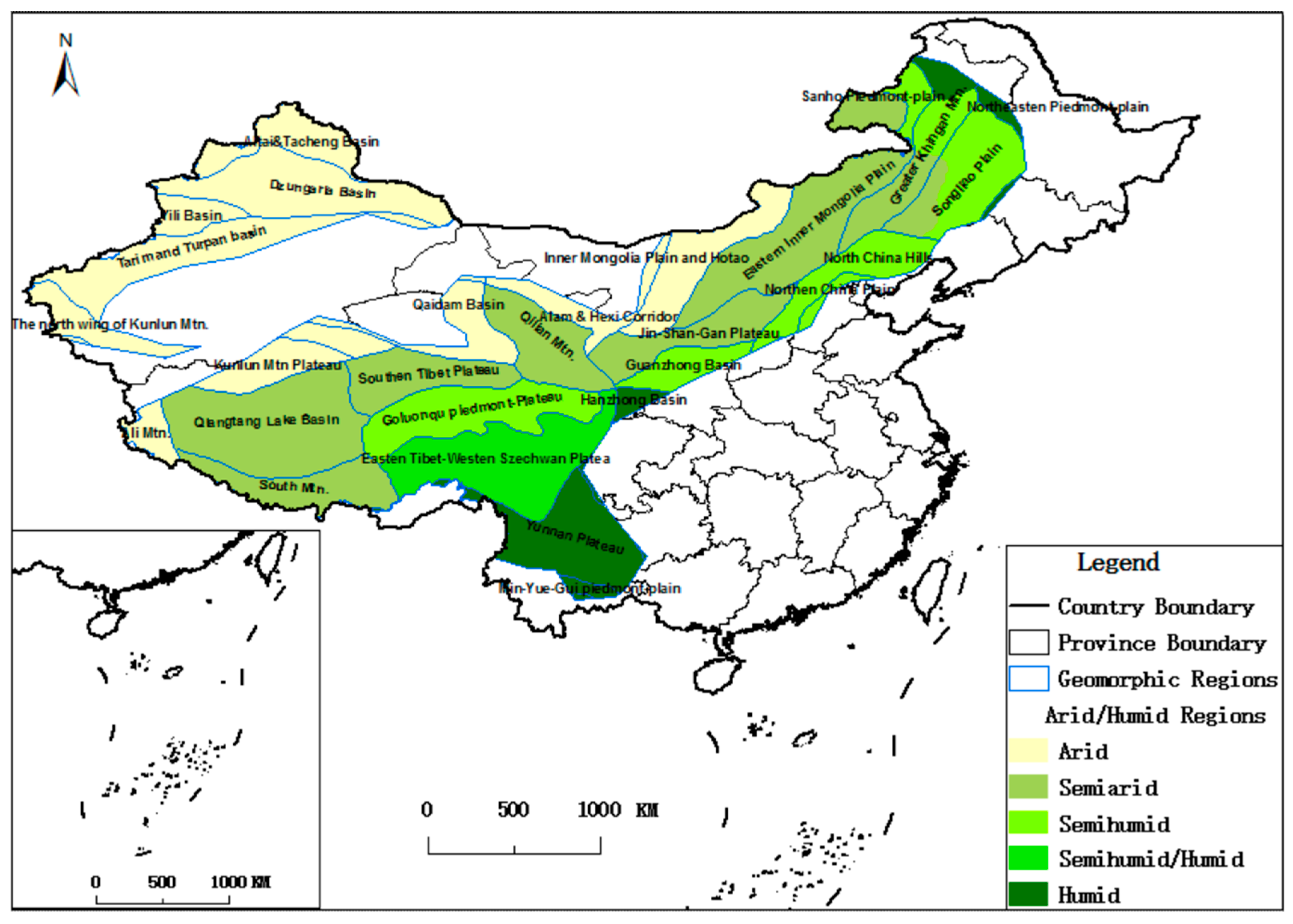
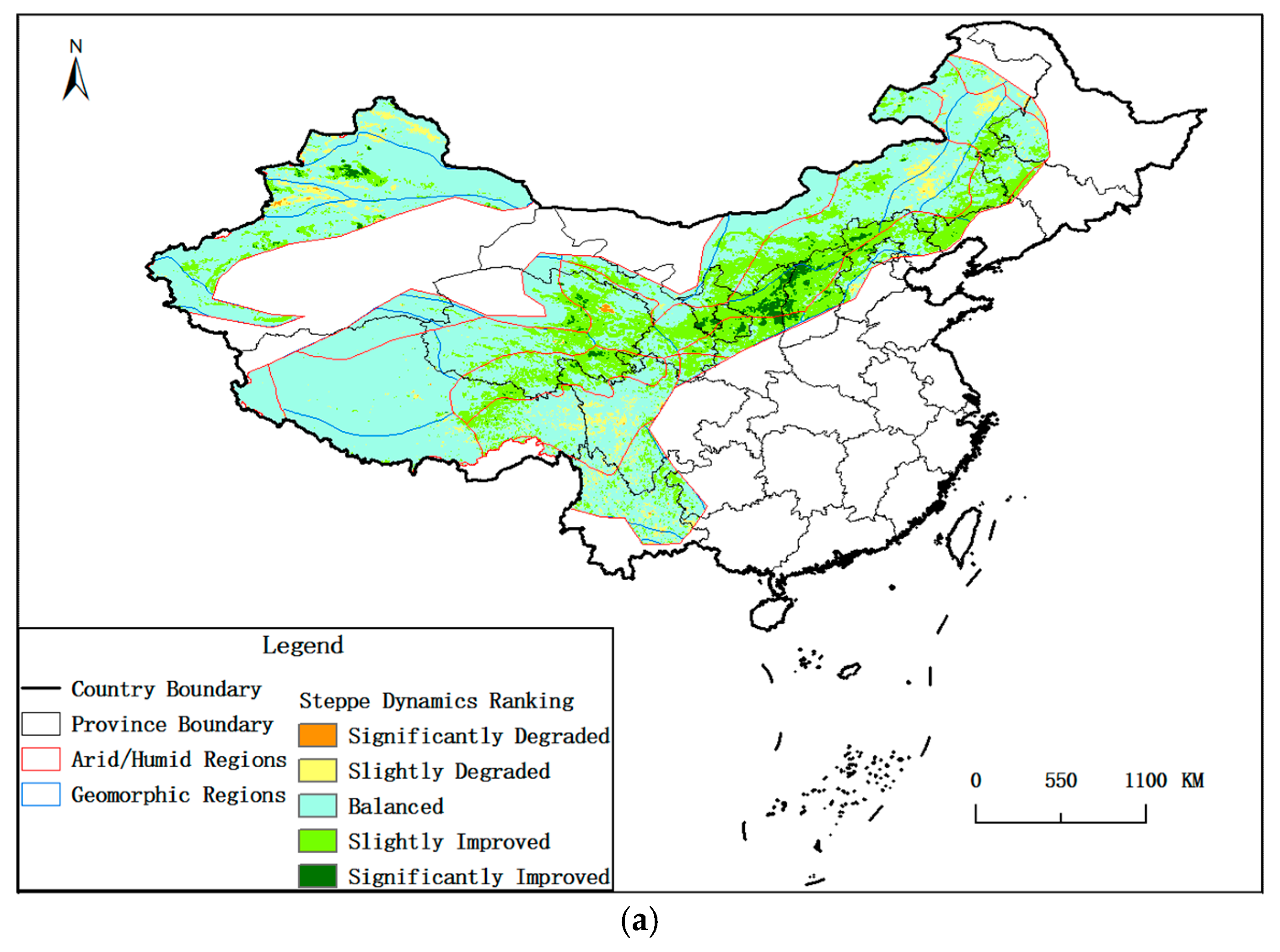
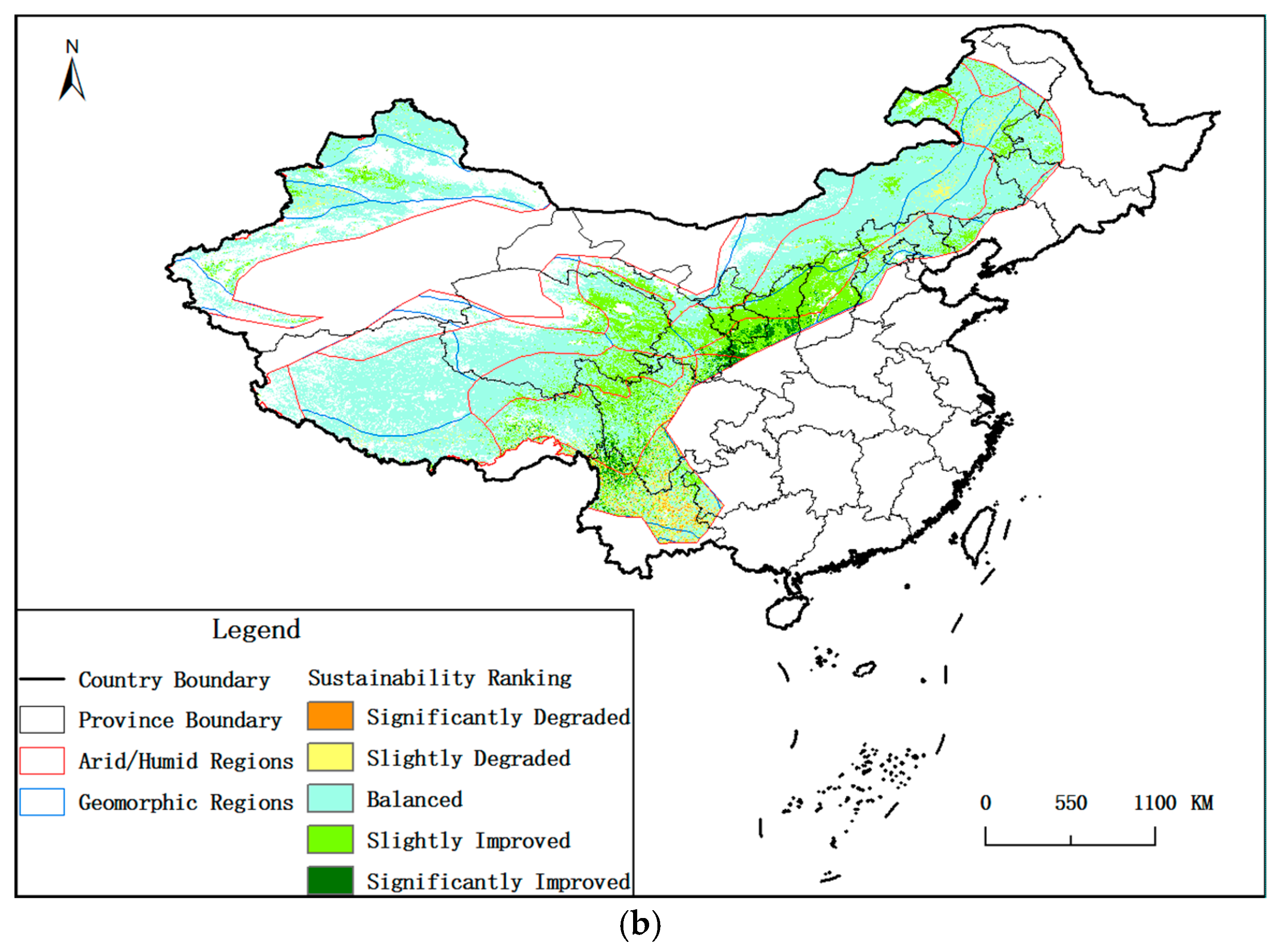
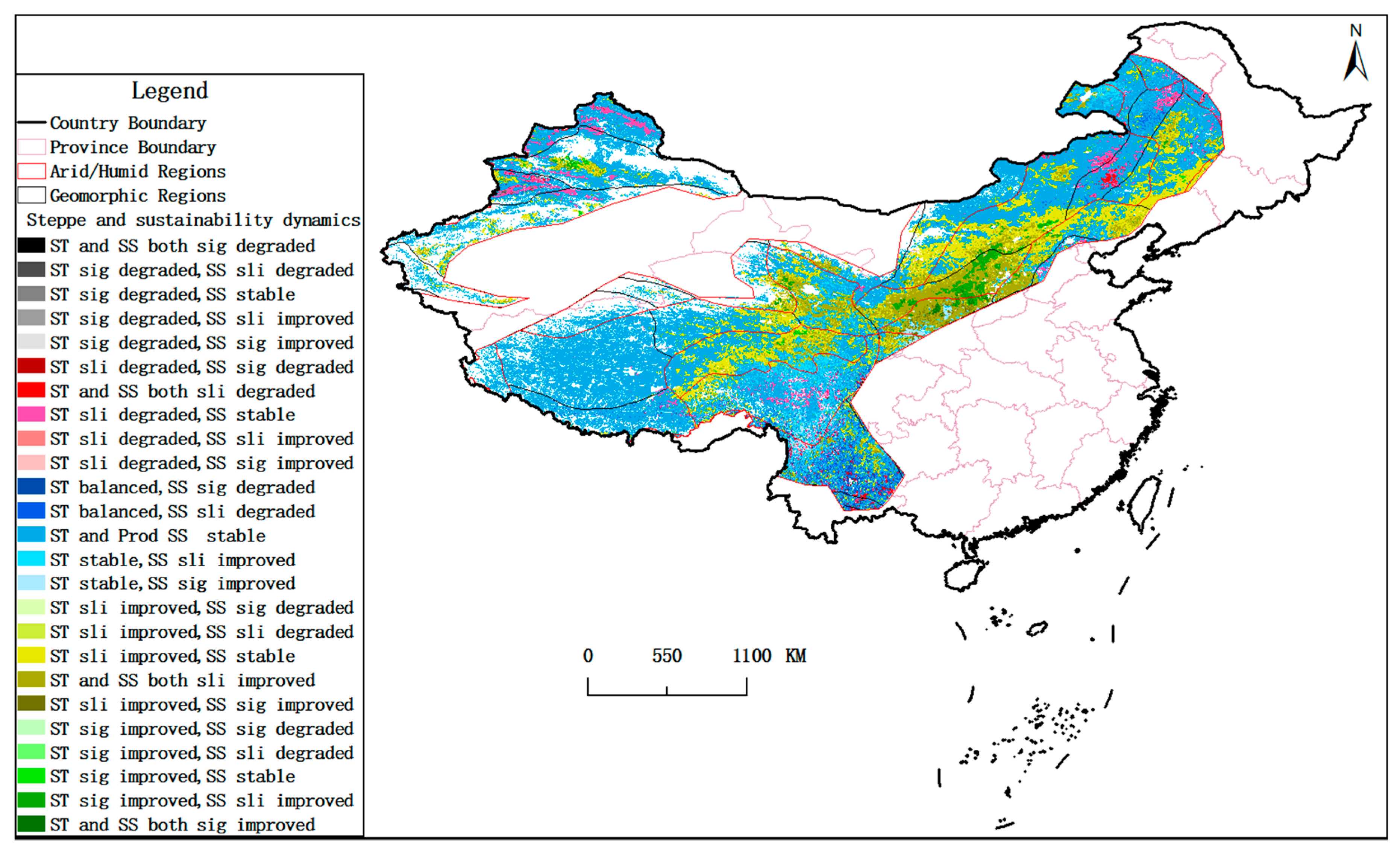
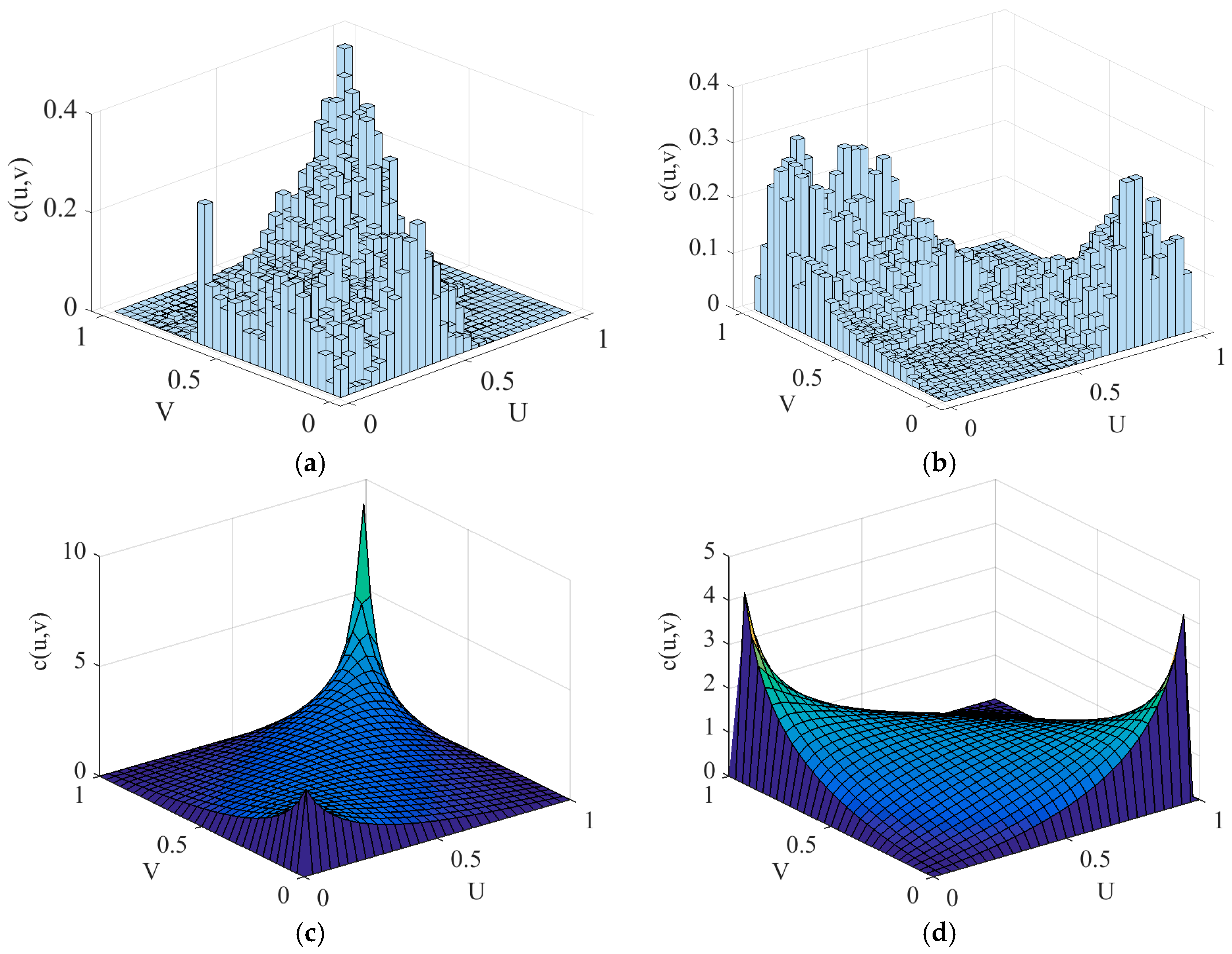
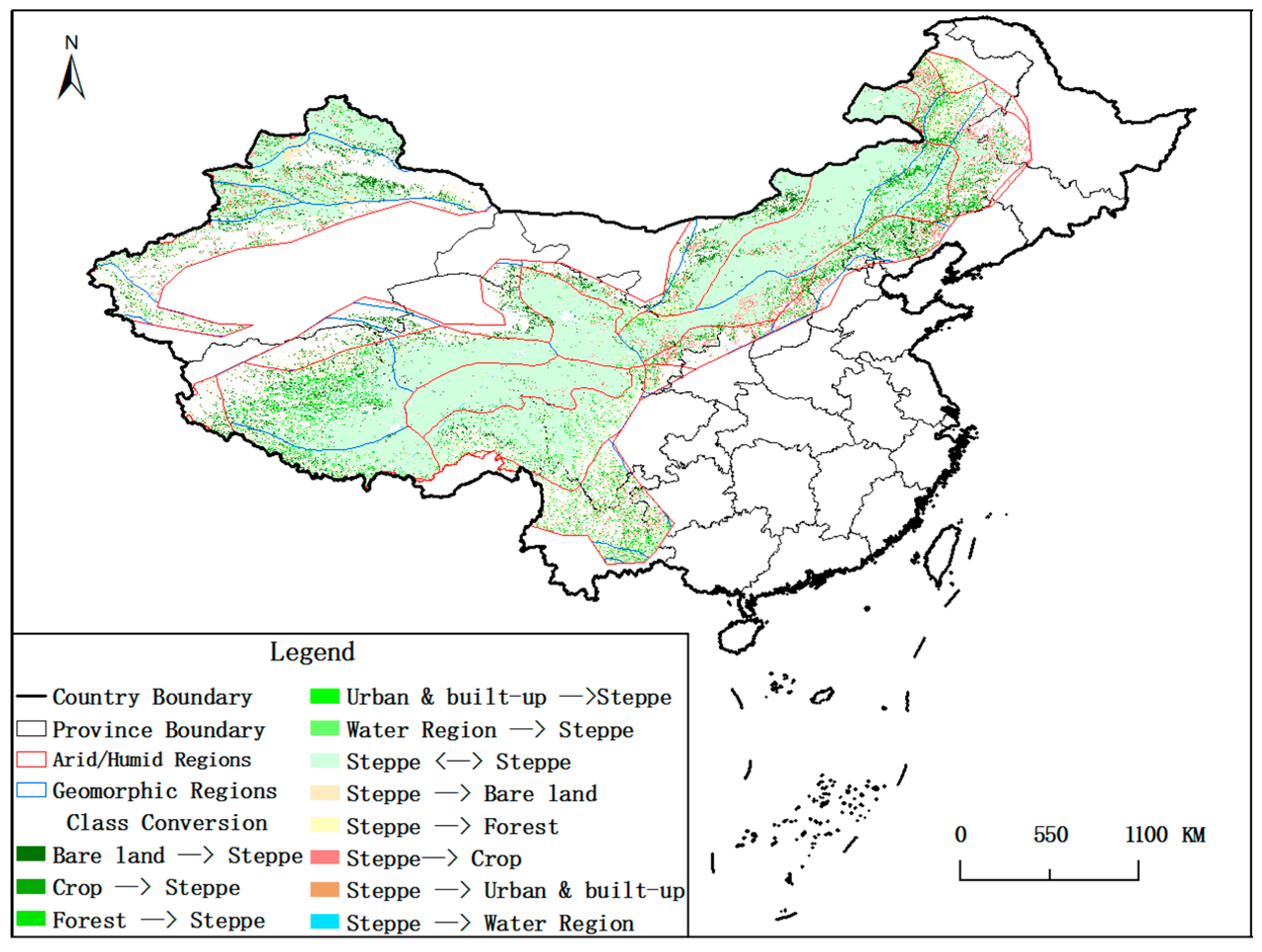
| Reclassified Class Codes | Reclassified Class Names | IGBP Class Codes | IGBP Class Names |
|---|---|---|---|
| 0 | water area | 0, 11, 15 | Water area, permanent wetlands, snow and ice |
| 1 | forestland | 1, 2, 3, 4, 5, 6, 7 | Evergreen needle-leaved forest, evergreen broad-leaved forest, deciduous needle-leaved forest, deciduous broad-leaved forest, mingled forest, closed shrub land, open shrub land. |
| 2 | steppe | 8, 9,10 | Multiple-tree grassland, savanna and grassland |
| 3 | crop land | 12, 14 | Crop land and the mosaic of crop and natural vegetation land |
| 4 | urban and built-up land | 13 | Urban and built-up land |
| 5 | bare land | 16 | Bare land or low-vegetation coverage area |
| 6 | others | 255 | Unclassified area and charging value |
| Rank | Ranks of Dynamics | Steppe | Sustainability | ||
|---|---|---|---|---|---|
| Area (km2) | Percentage | Area (km2) | Percentage | ||
| 1 | Significantly degraded | 2771.66 | 0.07% | 25,733.25 | 0.67% |
| 2 | Slightly degraded | 179,166.59 | 4.68% | 139,729.44 | 3.65% |
| 3 | Balanced | 2,538,072.19 | 66.31% | 2,900,185.16 | 75.71% |
| 4 | Slightly improved | 1,036,173.84 | 22.33% | 696,596.70 | 18.19% |
| 5 | Significantly improved | 74,230.11 | 6.68% | 68,169.85 | 1.78% |
| Year | Spearman Rank Correlation Coefficient | |||||
|---|---|---|---|---|---|---|
| Precipitation | Temperature Average | Sunshine Duration | ||||
| SA | SH | SA | SH | SA | SH | |
| 2001 | 0.18 | 0.61 | 0.20 | 0.64 | −0.31 | −0.56 |
| 2002 | 0.21 | 0.55 | 0.27 | 0.67 | −0.40 | −0.47 |
| 2003 | 0.28 | 0.56 | 0.25 | 0.69 | −0.55 | −0.40 |
| 2004 | 0.29 | 0.56 | 0.31 | 0.69 | 0.56 | −0.48 |
| 2005 | 0.26 | 0.57 | 0.21 | 0.63 | −0.48 | −0.49 |
| 2006 | 0.41 | 0.63 | 0.21 | 0.64 | −0.59 | −0.52 |
| 2007 | 0.27 | 0.69 | 0.30 | 0.64 | −0.60 | −0.65 |
| 2008 | 0.20 | 0.50 | 0.29 | 0.68 | −0.49 | −0.53 |
| 2009 | 0.29 | 0.59 | 0.21 | 0.64 | −0.55 | −0.43 |
| 2010 | 0.38 | 0.60 | 0.23 | 0.61 | −0.60 | −0.54 |
| Class Code | Class Name | Area Differences (km2) |
|---|---|---|
| 0 | Water area | −1063.14 |
| 1 | Forestland | −26,946.57 |
| 2 | Steppe | 0 |
| 3 | Crop land | 19,931.50 |
| 4 | Urban and built-up land | −354.41 |
| 5 | Bare land | 25,683.18 |
| 6 | Others | −20.94 |
© 2018 by the authors. Licensee MDPI, Basel, Switzerland. This article is an open access article distributed under the terms and conditions of the Creative Commons Attribution (CC BY) license (http://creativecommons.org/licenses/by/4.0/).
Share and Cite
Zhao, X.; Gao, Q.; Yue, Y.; Duan, L.; Pan, S. A System Analysis on Steppe Sustainability and Its Driving Forces—A Case Study in China. Sustainability 2018, 10, 233. https://doi.org/10.3390/su10010233
Zhao X, Gao Q, Yue Y, Duan L, Pan S. A System Analysis on Steppe Sustainability and Its Driving Forces—A Case Study in China. Sustainability. 2018; 10(1):233. https://doi.org/10.3390/su10010233
Chicago/Turabian StyleZhao, Xiangwei, Qian Gao, Yaojie Yue, Lian Duan, and Shun Pan. 2018. "A System Analysis on Steppe Sustainability and Its Driving Forces—A Case Study in China" Sustainability 10, no. 1: 233. https://doi.org/10.3390/su10010233
APA StyleZhao, X., Gao, Q., Yue, Y., Duan, L., & Pan, S. (2018). A System Analysis on Steppe Sustainability and Its Driving Forces—A Case Study in China. Sustainability, 10(1), 233. https://doi.org/10.3390/su10010233





